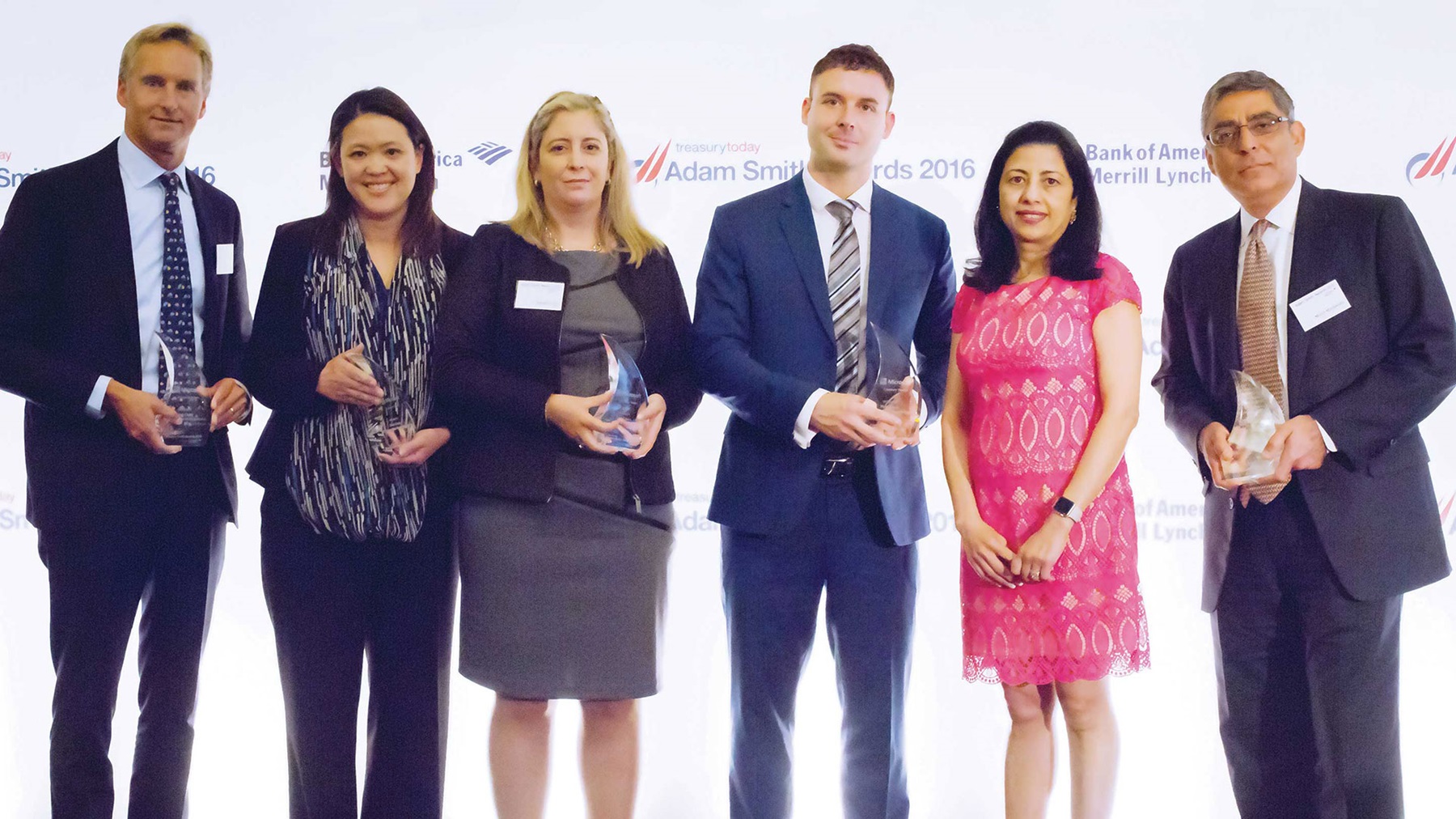
Photo of Craig Lewis, J.P. Morgan, Meggie Chichioco, Wells Fargo, Isabelle Cote, Citi, Jose Luis Marti and Anita Prasad, Microsoft and Mohit Manaktala, Bank of America Merrill Lynch.
The corporate finance team at this household name used to spend about a third of their working hours with banks and the boss wanted to know why? They implemented a bank relationship tracker to monitor bank engagement and improved their ROI considerably as a result.
Anita Prasad
General Manager, Treasury Capital Management
George Zinn
Corporate Vice President & Treasurer
Joel Combs
Director Corporate Finance & Investments
Chad Becker
Group Treasury Manager

Founded in 1975, Microsoft is the worldwide leader in software, services and solutions that help people and businesses realise their full potential.
in partnership with




The challenge
As 2016 began, in order to maximise efficiency, Microsoft’s corporate finance team was trying to prioritise its projects and daily operational work it needed to get done for the year ahead. As Anita Prasad, General Manager, Treasury Capital Management, recalls: “I asked everyone to do a high level calculation of the percentage of time spent on various activities. Although we know we spend a lot of time with our banks, I was shocked to discover that we meet with over 30 banks on a regular basis just for debt capital markets and share buyback work.”
The team discovered that each one of them spends over four months a year in bank meetings, roughly a third of their working hours. “Being a treasury professional, I immediately wanted to know the return on investment (ROI) on this time and bandwidth,” says Prasad. An added complexity at the company is that these banks are also customers of Microsoft therefore the challenge is to balance that aspect of the relationship when they consider why they are meeting with their banks.
Following the initial findings, they wanted to find out:
- Was this the best way to spend the team and banks’ time?
- What are the banks trying to achieve and do they get the desired outcome?
- What is Microsoft’s desired outcome from these meetings?
- Are there any tangible benefits?
- Is the additional carbon footprint worth it?
The solution
To answer these questions, Microsoft has designed a solution leveraging technology and using MS Excel to track the bank relationships. It includes a list of banks that the team should engage with for debt capital and buyback discussions, a system to create tiers of banks from the master list of banks and a defined total number of hours they will spend in meetings with Tier 1 and Tier 2 banks.
There is also a set target for the number of in-person meetings and Skype conference calls and the ability to track ‘unique’ ideas generated in meetings. No meetings are arranged for market colour or general updates and banks are rewarded for bringing forth creative intellectual property.
Joel Combs, Director in Corporate Finance, added: “The team is now in the midst of leveraging Microsoft’s cloud-based business intelligence technology, Power BI, to create visual and dynamic representations that can quickly tell them how productive these investments are.”
Table 1: Approach to Tiers
| Tier |
Title |
Coverage breadth |
Area depth |
Two-way relationship engagement |
| 1 |
Top relationship bank |
High |
High |
High |
| 2 |
Key partner bank |
Moderate |
High |
Moderate |
| 3 |
Partner |
Low |
Moderate |
Low |
| 4 |
Limited partner bank |
Low |
Constrained |
Low |
| 5 |
Very limited partner |
Low |
Low |
Low |
| S |
Diversity |
|
|
|
Source: Microsoft
Chad Becker, Group Manager, says: “For the banks, this solution has allowed them to invest their time and energy in coming up with creative ideas rather than wasting paper materials to publish ‘market colour’ binders which are out of date the minute they are published. Even in this short period, using this new approach we have come away with several ideas and we are looking forward to some ground breaking innovations, generated from a greener approach.”
Best practice and innovation
The team is consistently using the ‘bank relationship tracker’ to monitor the time spent with each bank against their maximum target for that tier of bank. Creative or value-add ideas that the bank present, tangible benefits from deploying these creative ideas and expectation setting with banks are also tracked.
George Zinn, Corporate Vice President and Treasurer said: “Perhaps most importantly though, Microsoft has seen an improvement in job satisfaction of team members since they no longer sit through meetings with five banks in a week, hearing the same market update five times. Instead, they are working on high priority projects and adding value to Microsoft.” He added that banks benefit because they are no longer focused on operational updates and instead can deliver strategic and value-add ideas that are unique and increase probability of productive engagement.
Key benefits
- Higher ROI on time spent in meetings.
- Clarity on expectations and desired outcomes for their banks and for the team.
- Added focus on unique value-add ideas that the banks can provide to distinguish themselves.
- Enhancing job satisfaction of the team.
- Encouraging green business practices and reducing travel expenses.
- Leveraging Microsoft’s cloud-based business intelligence technology, Power BI, to drive business insights.